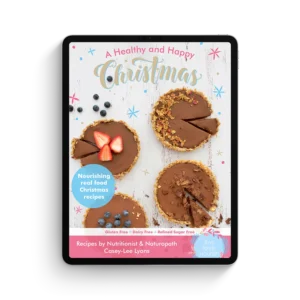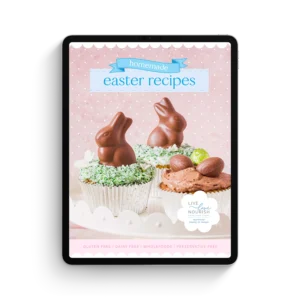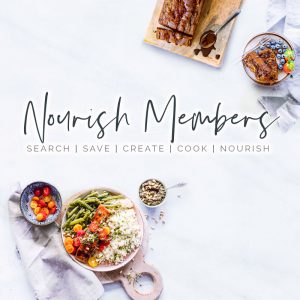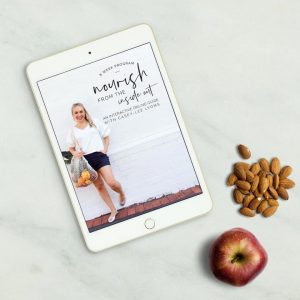How to pack a healthy lunch box + 30 gluten, dairy & nut free ideas
This post was updated Jan 2018 with more new ideas!
Having a little one of my own I understand the juggle of packing a healthy lunch box that ticks all of the boxes including fussy-eaters, food allergies and sensitivities (such as gluten free, dairy free, soy free, egg free, nut free and so on) as well as being kept simple when you are time-poor. This is why I try to keep all of my recipes on the website as well as my e-books simple and family-friendly with ways you can personalise to your family's needs.
As a naturopath and nutritionist I truly believe in the influence food has on their little bodies and that by feeding our littles ones nourishing whole-food we can give them the best opportunity for their health and to grow and learn.
Here are my tips to help you pack your child’s healthy lunch box to support their health, energy levels, focus and ability to learn at their best:
- Stick to REAL FOOD. Avoid processed and refined foods as much as you can (these are usually high in sugars and preservatives).
- Reduce sugar as much as you can too. Too much sugar can greatly affect their behaviour and concentration which ultimately affects how well they learn. Watch out for hidden sugars (found in muesli bars, muffins, biscuits and even flavoured yoghurt).
- Avoid soft drinks, cordials, juice poppers, flavoured milk (too much sugar and can impact their ability to learn). Good old water is the best way to hydrate them and all they need.
- Make sure the majority of your lunch box provides savoury options. (Reduces their cravings for sugar/ sweets. The more sweet food they eat the more they look for it).
- Ensure their lunch box is balanced with sources of quality protein (such as chicken, fish, eggs, meats or legumes), healthy fat (such as avocado, egg yolk, tahini used in hummus, olive oil) and non-refined carbohydrates (examples such as sweet potato, quinoa and whole fruit). Whole-food ingredients like these help to nourish their body with sustainable energy and adequate nutrition.
- Often kids are attracted to items that have a fun appeal such as fruit cut into shapes with cookie cutters, kebab sticks with chicken and vegetables or dips topped with funny faces using berries or pumpkin seeds. Get creative!
- If you have a fussy eater it helps if they choose a lunch box they love and will get excited about packing and taking to school.
- Get your kids involved in preparing lunch (even the night before). They are more likely to eat lunch that they have proudly prepared themselves.
- Find creative ways to incorporate more veggies. Whether its in a muffin (even zucchini can be hidden in sweet muffins), in egg muffins, spiralized zucchini as pasta etc.
- You'll find lots of healthy, family-friendly and kid-approved recipes in my recipe e-book.
30 Gluten Free, Dairy Free, Sugar Free and Nut Free Lunch Box Ideas:
- Mini frittata muffins (eggs, chopped vegetables and spring onion baked in a mini muffin tray) such as my eggy broccy muffins.
-
Fritters (eggs, grated vegetables and a touch of coconut flour cooked in a frying pan).
- 3 Ingredient Flourless Pancakes.
- Frittata or try my Rainbow Vegetable Slice.
- Meatballs, rissoles or chicken mince "poppers" (mini-meatballs) made with good quality mince and hidden grated vegetables. These are a great finger food high in protein for growing bodies. Give them a fun name such as the meatasaurus meatballs in my e-book.
- Avocado and tuna/salmon mash served with capsicum boats or cucumber rounds. (Rich in healthy fat and protein).
- Wraps made with an egg crepe to wrap up salad ingredients.
- Tuna or salmon patties (similar to bubble and squeak but add protein with canned tuna or salmon).
- Homemade sushi using nori sheets (sushi wrappers) filled with chicken, beef or egg, finely shredded salad such as carrot or cucumber and quinoa). My little one loves avocado, canned salmon (with the edible bones crushed for calcium) and quinoa mixed together and rolled in nori sheets.
- Whole fruit – berries are fantastic as is banana or apple. Remember that whole fruit is always a much better option than fruit juice (which has all of the fibre removed). My little one loves apple cut with a star and heart cookie cutter.
- Fruit kebabs. Veggie kebabs.
- Coconut yoghurt with berries mixed through.
- Cold chicken drumsticks, lamb cutlets or rissoles.

- Leftovers. A lot of kids love eating “dinner time” food (saving you time also by serving leftovers from last night’s dinner). Leftover stir frys is often a popular one or spaghetti bolognese served with zucchini noodles.
- Homemade, gluten free chicken nuggets (recipe for these along with my sugar free tomato sauce is in my e-book).
- Homemade treats such as sugar free Banana Bread, Mini Muffins, bliss balls or pikelets made with healthier flours such as coconut flour or buckwheat flour. Such as the my Coconut Pancakes (served with a sugar free chia jam) or the Flourless Pancakes.
- Cauliflower popcorn (recipe in my e-book).
- Cubes of roasted vegetables such as sweet potato or pumpkin.
- Meatloaf muffins (mince with hidden grated vegetables).
- Sweet potato sandwiches – large round slices of baked sweet potato with savoury fillings in between or Sweet Potato Sliders using roasted rounds of sweet potato for a bottom and top, filled with a thin mince meat/chicken burger patty, avocado and beetroot/tomato).
- Roasted chickpeas. Even whole canned chickpeas are great finger food.
- Kale chips or home-made roasted root vegetable chips.
- Sweet potato chippies (sweet potato cut into chips, tossed in olive oil and baked in oven).
- Quinoa fried “rice” (quinoa, peas, carrot, spring onion, garlic and egg) – quinoa is a protein-rich carbohydrate source great for supporting consistent energy levels.
- Quinoa salad – using quinoa as a base instead of lettuce is often more appealing to kids.
- Buckwheat pasta with tuna and peas.
- Zucchini noodles (we call these "green noodles") with leftover roast chook.
- Blanched asparagus spears. Surprisingly a lot of kids love munching on these "green wizard swords". The point here is to make it fun!
- Olives (pitted). These are rich in good fats and some kids love them. Worth a try!
- Don’t forget simple whole food ingredients such as steamed broccoli (or broccolini) “trees”, carrot sticks, beans, cherry tomatoes, chicken tenderloins or boiled eggs.
- If your child has a sweet tooth some healthy options that they might enjoy include whole fruit, slices of apple sprinkled with cinnamon, coconut water, fruit salad or sugar free jelly gummies made with gelatin and pureed fruit (I share how to make these in my recipe e-book).

Don't forget to keep trying! You just never know the day when your little one will finally try something after offering it over and over. It does happen! Keep being consistent and patient.
For more whole-food, family-friendly recipes check out my 8 Week Program. I've created all of the recipes to be family-friendly and even hubby approved. My recipe e-book also contains over 80 family-friendly recipes free from gluten, dairy and sugar.
I'd love to hear your healthy kids suggestions in the comments below so we can all inspire each other to nourish our little ones.




